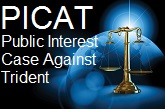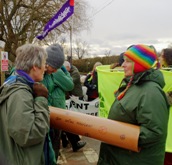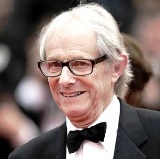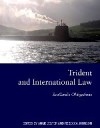Mary Mellor
Finance and the Arms Race
The most obvious link between finance, war and conflict is a longstanding public-private partnership – the arms trade. It was a republican president Dwight D Eisenhower who coined the phrase the military-industrial complex to describe this relationship, although it long precedes industrialism. What industry has such a range of products and conditions, from hand guns and instruments of torture to drones and nuclear arsenals? It does not matter if the products are used or not; time and technology will make them obsolete. It does not matter which side is being supplied as long as there is profit to be made. The source of finance is also both public and private from arms suppliers to the National Rifle Association to the commissioning and manufacture of Trident submarines. Over a trillion and a half dollars are spent on the military each year with most suppliers coming from the developed nations led by the United States, with many recipients coming from the developing nations, often contributing to the indebtedness of the latter.
War and Trade
Trade, finance and militarism have been closely linked in European history. The era of mercantilism that dominated Europe until the emergence of industrialism was based on military support of trade with foreign colonies and the calculation of a nation’s wealth by its ownership of precious metal bullion. European countries fought with each other to safeguard trading posts and trade routes. Spanish treasure ships from the New World were closely guarded by warships. Any less well protected merchant ships were harassed by official and unofficial pirates. The aim of mercantilism was to amass as much precious metal (particularly gold) as possible and establish trading monopolies and trading empires. A problem arose when areas of the world with desirable goods such as China refused to trade in return (nothing has changed in that regard!). In the early nineteenth century British silver piled up in China through its exports of silk, porcelain and tea. Britain retaliated by launching the Opium Wars to force China to continue to import Indian opium.
Banking Systems and War
The emergence of the modern banking system has also been closely linked to war and conquest. The early Italian bankers such as the Medici linked economic, military and political power. Alongside mercantilism, Europe was beginning the process of consolidation into what would become nation states. Disputed land was the basis of local wars, skirmishes, fortifications and standing armies. This cost a lot of money and local rulers often borrowed from rich merchant bankers if their tax receipts or precious metal holdings were not sufficient to fight wars. Repayment was often through some form of tax or trading monopoly or licence. A major origin of international banking was the crusades. Proto-banking networks such as the Knights Templar arranged the transport and international settlement of payments and debts to follow the route of the crusades. Equally the Rothschild banking empire was built during the Napoleonic wars.
War and Money are not necessarily linked
Most human societies have experienced forms of conflict and most societies have had a form of money (stones, shells, hieroglyphs, clay tablets) but the invention of gold coin has played a particular part in European history (Davies 2002, Ingham 2004, Mellor 2010). Money, banking and conflict all go back thousands of years but money as precious metal coinage is much more recent, invented in 630 BCE in present day Turkey. This led to the belief that money itself was valuable, rather than merely representing value as in a hieroglyph, clay tablet or stone. A gold coin may have the same value as a bank note, but one can be melted down and sold as a commodity, the other would just burn. One is purely social and political, a product of trust, authority and agreement, the other is made of something which many societies (but not all) see as precious. Economics textbooks will claim that precious metal coinage emerged from the needs of trade. It is asserted that prior to the invention of coinage trade was based on barter, which was very inconvenient. This totally misrepresents the history of coinage, also, there is no historical evidence for the barter story. Precious metal coinage emerged as a product of political authority not through trade. It was originally used mainly in the pursuance of empire building, that is, coinage was a mechanism of power. The right to coin money has always been heavily guarded by rulers.
Money, Conquest and Tax
Alexander the Great used the appeal of precious metal and the pressure of power in his military conquests. Empire-building relied heavily on mercenaries who were paid in silver coin. This was used by the soldiers to pay their way. While armies did rape and pillage, they also built economies as their coinage circulated among the camp followers who provisioned the soldiers. Why would local communities provision a conquering army? The political answer was taxation. As well as directly commandeering resources Alexander could demand that a tax be paid in coinage. This was a less violent way of making people part with their crops and resources. In order to pay the tax they needed to supply the soldiers in exchange for the coins.
Tax has been a major instrument of imperialism and colonialism, the Roman Empire behaved in much the same way. As not all the coinage was extracted as tax (British colonies extracted around 60% of the coinage they issued through tax) coinage based economies grew and economic imperialism gradually replaced direct military force. This was less successful in Britain, when the Romans withdrew, the use of coinage also disappeared for a considerable period. Even when silver and gold coins circulated widely, such as across Europe during the reign of Charlemagne (742-814) it was still a coinage for the elite rather than the mass of the people who used base metal or records of debts such as tabs, notched sticks or personal trust (Davies 2002).
Coinage and Nationhood
While coinage was an instrument of empire it was also a symbol of nationhood. One of the drivers in the American War of Independence was the refusal of the British to allow the settlers to create their own currency. Finance was also a major factor in the American Civil War. The South funded itself by issuing bonds based on the cotton trade. This was thwarted when the North blockaded Southern ports and the cotton bonds could not be redeemed. The North funded itself in a very modern way by issuing thousands of ‘greenbacks’ the forerunner of the modern dollar. This was secured on nothing but people’s trust in the broad economic capacity of the North. The modern dollar is backed by the same economic trust. While historically paper currency was based on a notional Gold Standard, since 1971 there has been no monetary link to precious metal.
National Banking and the National Debt
Although rulers monopolised the production of coin, the strength of their political power rested on their ability to tax it back, find new sources of precious metal, or get suppliers to take royal credit instruments such as tally sticks (Davies 2002). Many early banks were ruined by rulers defaulting. The Bank of England was set up in 1694 to finance the war with France. As the merchants who set up the bank did not trust the King to repay his debts they demanded that Parliament take on the £1.2 million loan as a National Debt. Ever since, the national budget has been a combination of coining, taxation and borrowing. As currency (coins and notes) have become less important as a form of money, the state is left with only taxation and borrowing. In reality, the state is perfectly capable of issuing new money electronically as in the case of Quantitative Easing, but neoliberal ideology demands that any such new money must only be issued as debt through the banking system. This stranglehold of the private sector over money supply has led to a new form of conflict, social breakdown as the state is ‘rolled back’ and the people are forced into austerity and impoverishment.
War and Money
Competition over colonial and military power culminated in the horrors of WWI and the unsustainable nature of the post war reparations leading to the collapse of the German money system were major contributing factors leading to WW2. Following the experience of war and the Great Depression, a more sensible post war settlement and the adoption of Keynesianism led to a period of economic stability in most of the combatant countries. However, there was little chance to reap the Peace Dividend as colonialism and inequality continued and a new enemy was found in the Cold War to justify huge expenditure on conventional and nuclear weapons.
The Gold Standard and its Demise
As the rapid expansion of leading global political and economic systems easily outstripped the production of precious metal, most payments were made in promissory form, that is, as credit or bank notes. In fact, throughout history most money has not been valuable in itself, but represented social agreements of trust. The use of precious metal did not need to take account of social and personal trust, so how were bank and credit notes to be regarded in the modern era? Launched in 1717 by Isaac Newton as head of the Royal Mint, a Gold Standard was proposed based on the promise to redeem bank notes for precious metal at the value of the time. It is arguable how far the Gold Standard really worked. It was suspended when more paper money was needed, particularly to fight wars. Its re-establishment in 1925 had a drastic impact on the British economy and it was finally abandoned in the 1930s. The United States maintained a dollar based Gold Standard until 1971, but this only applied to payments between central banks.
It was war, in this case in Vietnam, that finally destroyed the notion of a Gold Standard. In 1971 Nixon had to acknowledge that central banks around the world could no longer exchange dollars for gold. This did not stop the United States dominating the world economy, but trading countries started building up reserves of dollars, rather than gold (Rowbotham 2000). At first this was mainly the oil exporting nations as oil was traded in dollars. (Many people see the threat of Iraq to price its oil in euros as the real reason for the second Iraq war). OPEC price rises in the 1970s led to a surge in dollars which were recycled in loans to developing countries as banks sought profitable outlets for this growing ‘money market’. An irony was that one of the major innovators in lending dollars held in Europe (so-called Eurodollars) was a Soviet bank, Narodny, which had taken its dollars out of the United States in 1956 in case they were frozen by the US after the invasion of Hungary.
Money and Third World Debt
The notional Gold Standard had allowed nations to control exchange rates and the movement of finance around the world. As national controls broke down, a flood of globalised finance swept around the world looking for profitable opportunities. Western banks found themselves swamped in currency with no ready source of investment. Most western economies had been stagflating after the years of postwar reconstruction and could take no more investment. Instead a debt explosion was triggered in the Majority world. Many Majority nations had recently been liberated from colonialism and were keen to modernise their economies and build up national prestige project as well as build up military forces. In fact, many had experienced coups and become military regimes. New elites also emerged and corruption was rife. Loans were made at relatively cheap interest rates. However within ten years as monetarist theory replaced Keynesianism, interest rates rose sharply and many countries found themselves with unsustainable debt. Repayments began to outstrip the original loan schedules. Campaigners eventually managed to get some loans to the poorest countries cancelled, but much of the debt had been sold to so-called ‘debt vultures’ who demanded payment of the whole original sum.
The Globalisation of Finance
The financial expansion of the 1970s exploded in the 1980s as governments such as Britain and the US acknowledged that they could no longer control financial movements and relaxed their regulations. This was described as ‘Big Bang’ in the UK. In particular, floating exchange rates saw an exponential growth in finance trading, particularly derivatives. These are purely financial gambles, largely related to movements of currency. In the run up to the 2007-8 crisis, derivative trading outstripped global production by ten to one. As the financial crisis has shown this has led to global instability. Apart from the neoliberal push for austerity, private speculation (hot money) has undermined currencies around the world. Hot money has also led to sharp rises in commodity prices which has caused social unrest and many argue was a major factor in the Arab Spring (WDM 2011). Conflict in itself is not a bad thing if people are struggling for their freedom and political and economic rights, but globalised finance does not separate progressive from oppressive regimes. It will destroy both if a profit is to be made.
Currency Wars?
One of the major potential sources of instability is a new form of mercantilism. Instead of fighting each other to accumulate gold, countries are fighting each other via, even within, their currencies (Rickards 2011). Witness the crisis in the Eurozone with disputes across states but within a currency, and the debate over the value of China’s currency as against the dollar. As a result of the globalisation of production, countries with major resources or high levels of production are storing up reserves of other currencies, particularly the dollar. Sixty-four per cent of reserves across the globe are held in dollars, a good proportion by China. China has reinvested much of this in US government debt, but is also using its reserves as a Sovereign Wealth Fund to buy up resources and land around the world.
At one level, countries using and holding each other’s currencies could be seen as a good thing, fulfilling the promise of neoliberalism by turning the world into one large economy. On the other hand, a nation’s currency reflects a potential call on its labour and resources. Holding a nation’s currency is very different from holding gold, which is a commodity in itself. A fiat currency (i.e. a currency not made of, or backed by, a commodity) is a promise, a debt. As with all fiat currencies, the backing for that promise is the goods, services, resources, possessions of the people in whose name that currency was issued. Given that globalised trading and finance has produced almost unlimited amounts of money designated in national currencies, it is the people in those nations who will have to honour that debt. This is the message of the financial crisis – the people have had to pay in austerity for the activities of privatised finance. Their wages and benefits are being cut and they are being asked to sell off (privatise) their national assets.
Who Controls Money?
If the global flow of money is in danger of causing currency wars, if not actual war, or causing social breakdown, fundamental questions need to be asked about the ownership and control of money. National currencies, or electronic or paper promises made in their name, do not come from nowhere. Modern money has two sources, the national mint/central bank (historically notes and coin, but now also electronic quantitative easing) or bank issued ‘credit’ through loans or overdrafts. The main difference between the two forms of money is that historically (but not so much recently) state issued money was spent into the economy and reclaimed by taxes whereas all new money issued by banks is created as debt, it must all be repaid with interest. Economic text books will argue that only state money is ‘real’ money while bank money is only a form of credit. They will also claim that banks are merely acting as a link between savers and borrowers. Neither is true. As the banking crisis showed, central banks have had to rescue all forms of financial institutions and accounts. Also, bank deposits hugely outstrip the issue of currency by 97% as against only 3% in the UK.
Every time someone takes out a mortgage, a small company increases its overdraft, or a hedge fund borrows millions to make a split second gamble (so-called leverage) they are creating money. All the new debts are designated in a national currency and the people of that nation are responsible for honouring that money as it is spent into circulation. Issuing the money supply of a nation through debt is also highly unsustainable. Firstly all that money has to be paid back with interest, and as the only source of new money (or at least 97% of it) is debt, more debt must be taken out if there is to be sufficient money in circulation to pay previous debts with interest. This also drives economic growth, people have to work harder, use more resources, find some means of making a profit, driving down wages, standards etc. Eventually people can take no more debt and the whole money supply starts to unravel, as in the credit crunch and the financial and economic crisis that followed. Paper promises have been allowed to flow around the world and the people in whose name they are made have had no say in the economic choices that have been made. Equally they have no say in the conflictual positions created by profit-seeking companies which often have to be rescued by military intervention. In particular there is likely to be conflict in the ever-increasing scramble for resources in a resource-limited world (Panayotakis 2011).
Peaceful Solutions?
After the calamities of two world wars there was a concerted attempt to find a structure within which economic relations between nations could proceed. At the Bretton Woods Conference of 1944, Keynes’s solution was to have a buffer currency in which global trade would be conducted, he proposed to call it a ‘bancor’ (bank gold). Countries would be penalised if they went too far into deficit – but also if they went too far into surplus. The world economy like a national economy cannot work if it gets too imbalanced. The solution in national economies is to channel money or economic stimulus to poorer parts of the country – Liverpool is not expected to be as successful as London. This is a lesson that has not been learnt in the Eurozone. From a Keynesian perspective markets should be seen as a relationship not a competitive struggle to the death. Unfortunately Keynes was defeated by a US proposal to make the dollar the main global currency. This enabled the US both to support and dominate global post war reconstruction (Yaroufakis 2011).
A major problem in the international context is the relationship between reserve and non-reserve currencies. Put brutally, the United States as the world’s dominant currency in which many commodities are priced (particularly oil) can issue as many dollars as the world will stand, to buy the goods and services it needs. Non-reserve countries have first to earn one of the major currencies (dollar, euro, yen) before it can buy goods on the international market. In the absence of a global currency (like a global euro) or a buffer currency as Keynes suggested, whichever country has control of the dominant currency can consume the world’s goods effectively for free. The disadvantage is that the countries supplying the dominant economy with goods are storing up that currency which is a call on future goods, services and assets of the dominant economy. Where major currencies have effectively let the profit-based financial sector gain control of the nation’s money supply, it is profit seeking companies who have gained control of the world’s resources. Around 40% of global trade is conducted entirely within single transnational corporations, with all the opportunity for tax and price manipulation that presents.
Given the experience of the euro, we are a long way from having a global currency or a buffer currency as Keynes suggested. This leaves action at the national level in relation to national currencies. The most important reform would be to stop the financial sector creating new money, that is, controlling the money supply. This would mean that banks could only lend money that is put on long term deposit, that is, do what the text books claim they do, act as a link between borrowers and investors/savers. Ordinary bank deposits would be administered separately to enable transfer payments etc. Control of money supply would return to public issue under democratic control which, hopefully, would not give a priority to armaments. This money would be spent into circulation on public services, be allocated to development banks to provide credit for businesses or be given directly to the people, for example as a basic income (Hanlon 2010). Taxation would be used to manage the overall money supply, penalise anti-social or resource wasteful activities and redistribute wealth.
A major reform would be to demand that transnational trade should be conducted by each nation in its own currency. For example, a US company selling to Nigeria would be obliged to accept payment in Nigerian currency. However this would not overcome the inequality between currencies.There would still be need for an international buffer between currencies as Keynes suggested. If no currencies traded directly with each other, this would immediately remove the basis of most financial speculation through derivatives. The critical question would then be the exchange rate at which each currency would ‘buy’ the global buffer currency. My suggestion would be that the exchange rate for each currency should have a social base such as a measure of income/labour as against the buffer currency. This would equalise the purchasing power of each currency and remove the benefit of shifting production to cheap labour countries. It would also mean poorer countries would pay less for global goods. A US person would buy a product for a global price set in the buffer currency related to her rate of pay (100 globals = 100 X $ hourly rate); equally, a Nigerian could buy the same product at her rate of pay (100 globals = 100 X Naira hourly rate). I prefer to call the buffer currency globals, as Keynes’ concept of banc-or (bank-gold) implies a link to gold.
Historical evidence shows that finance, trade and military activity are closely intertwined. War is good for finance, it unleashes massive demand even as it destroys environments and lives. The present globalised money system creates many areas of actual and potential conflict. Let us hope that nations will be able to find national and global financial structures that will allow them settle their trading and financial obligations to each other in peaceful, ecologically sustainable and socially just ways (Salleh 2009).
References and Further Sources
Glynn Davies (2002) A History of Money University of Wales Press
Joseph Hanlon, Armando Barrientos and David Hulme (2010) Just Give Money to the Poor:The Development Revolution from the Global South Kumerian Press Sterling VA
Geoffrey Ingham (2004) The Nature of Money Polity, Cambridge
Mary Mellor (2010) The Future of Money: From Financial Crisis to Public Resource Pluto Press.
Mary Mellor Bringing Economics Down To Earth http://www.youtube.com/watch?v=9F-DuD6T_i0
Mary Mellor Just Banking http://www.youtube.com/watch?v=uAhxDsm0eZE
Mary Mellor Understanding Money 1: What is Money?
http://www.youtube.com/watch?v=5IZRWQn5jgk
Mary Mellor Understanding Money 2: Money and Banking
http://www.youtube.com/watch?v=8wpbnYZZaG4
Mary Mellor Understanding Money 3: The Crisis
http://www.youtube.com/watch?v=PoIRCHq7Cr4
Mary Mellor Understanding Money 4: The Future of Money
http://www.youtube.com/watch?v=argEb1tWtt0
Panayotakis, Costas (2011) Remaking Scarcity: From Capitalism Inefficiency to Economic Democracy Pluto Press
James Rickards (2011) Currency Wars: The Making of the Next Global Crisis Penguin London
Michael Rowbotham (2000) Goodbye America! Globalisation, Debt and the Dollar Empire Jon Carpenter Charlebury
Ariel Salleh (Ed) (2009) Eco-sufficiency and Global Justice: Women Write Political Ecology Pluto Press, London
World Development Movement (2011) Broken markets: How financial regulation can help prevent another global food crisis. Report.
Yaroufakis, Yanis (2011) The Global Minotaur Zed Books, London
Mary Mellor is Emeritus Professor in the Department of Social Science and Languages at Northumbria University Newcastle upon Tyne, UK












 Nuclear weapons crime in the UK has been reported to Thames Valley Police.
Nuclear weapons crime in the UK has been reported to Thames Valley Police.










